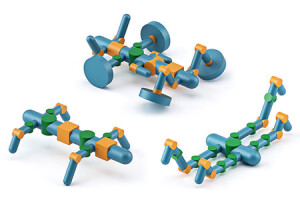Computer-aided creativity in robot design
 So, you need a robot that climbs stairs. What shape should that robot be? Should it have two legs, like a person? Or six, like an ant? Choosing the right shape will be vital for your robot’s ability to traverse a particular terrain. And it’s impossible to build and test every potential form. But now an MIT-developed system makes it possible to simulate them and determine which design works best.
So, you need a robot that climbs stairs. What shape should that robot be? Should it have two legs, like a person? Or six, like an ant? Choosing the right shape will be vital for your robot’s ability to traverse a particular terrain. And it’s impossible to build and test every potential form. But now an MIT-developed system makes it possible to simulate them and determine which design works best.
You start by telling the system, called RoboGrammar, which robot parts are lying around your shop — wheels, joints, etc. You also tell it what terrain your robot will need to navigate. And RoboGrammar does the rest, generating an optimized structure and control program for your robot.
The advance could inject a dose of computer-aided creativity into the field. “Robot design is still a very manual process,” says Allan Zhao, the paper’s lead author and a PhD student in the MIT Computer Science and Artificial Intelligence Laboratory (CSAIL). He describes RoboGrammar as “a way to come up with new, more inventive robot designs that could potentially be more effective.”
Zhao is the lead author of the paper, which he will present at this month’s SIGGRAPH Asia conference. Co-authors include PhD student Jie Xu, postdoc Mina Konaković-Luković, postdoc Josephine Hughes, PhD student Andrew Spielberg, and professors Daniela Rus and Wojciech Matusik, all of MIT.
Ground rules
Robots are built for a near-endless variety of tasks, yet “they all tend to be very similar in their overall shape and design,” says Zhao. For example, “when you think of building a robot that needs to cross various terrains, you immediately jump to a quadruped,” he adds, referring to a four-legged animal like a dog. “We were wondering if that’s really the optimal design.”
Zhao’s team speculated that more innovative design could improve functionality. So they built a computer model for the task — a system that wasn’t unduly influenced by prior convention. And while inventiveness was the goal, Zhao did have to set some ground rules.
The universe of possible robot forms is “primarily composed of nonsensical designs,” Zhao writes in the paper. “If you can just connect the parts in arbitrary ways, you end up with a jumble,” he says. To avoid that, his team developed a “graph grammar” — a set of constraints on the arrangement of a robot’s components. For example, adjoining leg segments should be connected with a joint, not with another leg segment. Such rules ensure each computer-generated design works, at least at a rudimentary level.
Zhao says the rules of his graph grammar were inspired not by other robots but by animals — arthropods in particular. These invertebrates include insects, spiders, and lobsters. As a group, arthropods are an evolutionary success story, accounting for more than 80 percent of known animal species. “They’re characterized by having a central body with a variable number of segments. Some segments may have legs attached,” says Zhao. “And we noticed that that’s enough to describe not only arthropods but more familiar forms as well,” including quadrupeds. Zhao adopted the arthropod-inspired rules thanks in part to this flexibility, though he did add some mechanical flourishes. For example, he allowed the computer to conjure wheels instead of legs.















